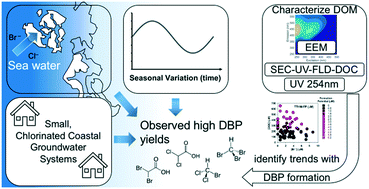Drivers of disinfection byproduct formation and speciation in small, chlorinated coastal groundwater systems: relative roles of bromide and organic matter, and the need for improved source water characterization and monitoring†
Abstract
Numerous small public groundwater systems on coastal islands in Washington State (WA) that are susceptible to seawater intrusion have reported disproportionately high frequencies of regulatory exceedances for halogenated organic DBPs; especially brominated DBPs. Fifteen such systems spread across a ∼1000 km2 study area were monitored quarterly over a year in a collaboration between the WA Department of Health and University of Washington to identify key drivers of these trends, and to develop operational and regulatory recommendations aimed at minimizing DBP formation in these and similar systems in WA and elsewhere. [Br−] alone was not observed to be a strong predictor of DBP formation potentials (DBP-FPs) or speciation for source waters across the study area, likely due to accompanying large variations in [DOC]. However, bromine substitution factors correlated relatively well with [Br−]/[DOC] ratios, highlighting the importance of both [Br−] and [DOC] in governing DBP formation and speciation in coastal groundwaters. Overall DBP-FPs correlated strongly with [DOC], UV absorbance at 254 nm (A254), and selected size exclusion chromatography (SEC) and fluorescence metrics for each groundwater, with A254 a particularly strong surrogate for DOC. This was consistent with high uniformity of DOM properties (confirmed from SUVA254, fluorescence index, PARAFAC components, and SEC chromatograms) across the study area. Specific DBP-FPs (e.g., ∼72 μgTTHM mgC−1) for the source waters were quite high compared to typical groundwaters, pointing to inherently high DOM reactivity as an additional factor in the frequent DBP regulatory exceedances observed for the investigated sites. Measurements also revealed seasonal trends (e.g., in [Br−] and [DOC]) correlated with DBP formation, but not captured by routine regulatory monitoring, as well as widespread inconsistencies in chlorination practices at the studied systems. While such factors and correlations are well established for surface waters, this work provides one of the few examinations incorporating both laboratory and full-scale observations to demonstrate their importance in small, coastal groundwater systems. Based on these findings, WA has adopted a number of changes in its design manual for new groundwater disinfection systems, and is evaluating changes in its disinfection monitoring and DBP programs that may also serve as models for wider implementation.



 Please wait while we load your content...
Please wait while we load your content...
